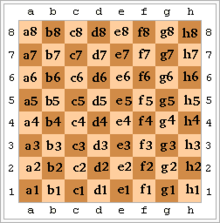The algebraic notation of chess


As we progress in the learningChess we should also get used to using the written language called Algebraic notation, which is used to represent the different moves that are executed by both players.
When you get to play at tournament level it is an obligation to record the plays made by you and your opponent using the Algebraic notation. It is not as difficult to learn as it seems when we first came into contact with it. The first thing we must be clear about is that each of the 64 squares on the board corresponds to a pair of characters composed of the respective letters of each column and line (row). The columns from "a" to "h" are assigned from left to right (lowercase). €lines 1 to 8, assigned from bottom to top.
In the Algebraic notation each piece receives a letter, which in English would be: C=knight, A=bishop, T=rook, D=queen and R=king. The pawn does not have a letter assigned to it. The moves are scored evenly, first White's move and then Black's (if so agreed). Only the final movement is noted, starting with the letter of the piece and the finishing position without spaces or hyphens. In the event that a move involves capture, an "x" must be placed after the letter of the piece or after the starting column, if it is the pawn.
There are moves in which confusion should be avoided, when, for example, two similar pieces can simply move to the same place or capture the same piece. To differentiate the moved piece we will only have to add from the letter of the piece, the letter of the column if the pieces are on the same line or the letter of the row if they are in the same column.
If the move involves castling, it is symbolized by "0-0" for short castling and "0-0-0" for long castling. Finally, make it a habit to use "+" for check, ++ or # for mate, and a.p to designate a catch. Write them after the motion notation.
The Algebraic notation of chess is the best way to analyze your entire set of Chess. Thus, by recreating the game played you will be able to analyze your weaknesses and strengths that you will have to improve or reinforce for your next match.
Related posts:
Chess as a sport
The importance of openness in a chess game
The value of the chess pieces
How to avoid falling into the drowning situation

Leave a Reply